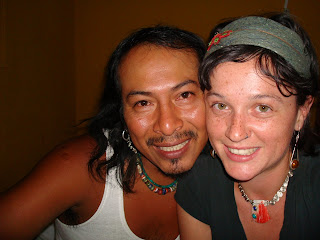
After Mancora we headed through Lima and to Huacachina. Huacachina is a tiny desert oasis in the middle of massive sand dunes. It's surreal, and also a popular tourist spot. Every city we go to, Ata knows people- his mobile community. Because he's been going to these places so long, he gets discounts on lodging and food. In Huacachina there's a place he can camp for free, and when foreigners paid 8 sols for a meal, we paid 4.
He also knows his clientele, and is amazing at telling where people are from. He'll nod toward someone strolling in the distance, "Canadian" or "Israeli" or "French". How do you know?! He knows greetings and funny phrases in Hebrew, French, Dutch, English, Japanese, Italian, and Quechua.
It was here in Huacachina that I met volunteers who are helping to reconstruct damaged buildings from last August's earthquake. They are international volunteers, based in Pisco with Burners Without Borders, an organization formed by American Burning Man folks. Pisco was hit the worst, but even in neighboring cities, I was shocked by how in ruins the cities still were. You'd think the earthquake happened last week. International reports put the quake around an 8.4, but official reports from the government said it was a 7.9. Oddly enough, it's only considered a national emergency in Peru with the govt required to help the people when it's an 8 or more.

It was also here that I celebrated Earth Day, or Dia de La Pachamama. Here they had a big garbage clean-up, something desperately needed in most Latin American cities. You fill up a garbage bag of trash and bring it to a collection site, and they give you one ticket per bag. Then after 6pm, local participating businesses give a free prize for your ticket. There was personal pizza at a pizzeria, free drinks at bars, chocolate candies, bottled water, soda, real coffee. Pretty good incentives for one bag of trash.
After Huacachina we continued south, to Nasca, then to Arequipa, where I got a great haircut for 2.5 sols, less than a dollar. From Puno we crossed to Copacabana, Bolivia together. It is a sweet little city on the shores of Lake Titicaca. There were a lot of Argentinian artisans, so many it was almost hard to find a place to put the parche. There are a lot of unspoken rules about where it's okay to vend- not in front of a business, a doorway, or in a spot where someone more established and longer-residing always sets up. From here you can catch a boat to the Isla del Sol, the birthplace of the Incan sun god. There are a lot of sacred ruins, mostly pre-Inca, and a beautiful trail to walk across the island.
Little did we know we had arrived just in time for a huge festival weekend, the Festival Del Señor de La Cruz. Unfortunately it meant that prices skyrocket- on Thursday we paid 15 Bolivianos each for our hotel, and Friday night it was 40. On Friday morning a parade started with several marching bands, folk dancers, and traditional costumes... and didn't stop until Sunday afternoon. Sometimes the performances were precise and tight, or sometimes in the middle of the parade, an overheated dancer would take off his headdress and stand and drink a beer. By the evening, most people were drunk as skunks, and it's a religious festival! The indigenous women stumbled around the street in bright colorful dresses with gold embroidery, some in plastic but fancy almost space-age looking outfits. Ata and I would weave past them to get to the market, for our evening cup of coca tea or api, a sweet hot drink made from corn, lime, and cinnamon.



